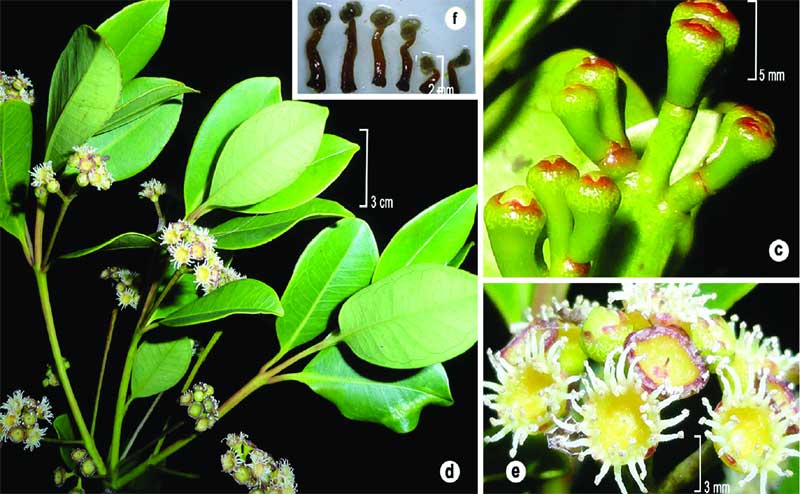

In a significant addition to the rich botanical diversity of the Western Ghats, a team of scientists from the Kerala Forest Research Institute (KFRI) has identified a new species of the myrtle genus (Syzygium), naming it Syzygium sahyadricum. This newly described species was discovered during floristic explorations in the remote interior forests of the Eravikulam National Park, located in the high-altitude shola forests of the Anamalai and Palani Hills. The discovery was made by botanists P. Sujanapal, A.J. Robi, and N. Sasidharan.
Growing at elevations above 1,800 meters, Syzygium sahyadricum is adapted to the unique montane shola ecosystem of the southern Western Ghats. It is a medium-sized tree that grows up to 12 meters tall. The bark is pale brown and smooth with a pinkish inner surface, and its branchlets are distinctively quadrangular. The leaves are elliptic-oblong with slightly revolute margins and exhibit a striking colour contrast—shiny greyish-yellow on the underside with prominent horizontal brochidodromous lateral nerves, typically arranged in 12–16 pairs. Tender leaves are pale yellow, which, along with their white flowers and specific fruit morphology, distinguishes the species from similar taxa.
The plant flowers in December and bears edible, dark purple, oblate to obovoid fruits between March and May. The inflorescences are lateral or axillary, emerging from old leaf scars, and form a reduced metabotryoid structure with flattened peduncles towards the apex—features that are critical to its identification.
Despite being collected more than a century ago by the famed British botanist J.S. Gamble during his studies in the Madras Presidency, the species was long misidentified as Syzygium spathulatum, a species endemic to Sri Lanka. The resemblance in leaf shape—elliptic-oblong in both species—contributed to the confusion. However, S. sahyadricum differs significantly in having pale yellow young leaves and white flowers, whereas S. spathulatum features copper-colored new foliage and pale pink blossoms.
The identification was confirmed after a comprehensive comparative analysis of herbarium specimens housed in the Madras Herbarium, Rapinat Herbarium (Tiruchirapalli), Calicut University Herbarium, and the Botanical Survey of India (Pune). Specimens similar to S. sahyadricum were found mislabeled as either S. caryophyllatum or S. spathulatum, emphasising the need for taxonomic clarity in the genus.
In local communities near the discovery sites, the tree is referred to by vernacular names such as “Pottinjaval” and “Pillanjaval.” However, these common names are often applied broadly to multiple Syzygium species. As is common in ethnobotanical contexts, subtle differences between species may go unnoticed at the community level, with the same name used for distinct species.
While the new species has been taxonomically validated and illustrated, its potential medicinal or economic value remains unexplored. Several species in the Syzygium genus, such as S. cumini (also known as jamun), are recognised for their health benefits and commercial applications. As such, S. sahyadricum may hold untapped therapeutic or ecological value. “It remains to be seen what this species holds within it,” noted P. Sujanapal, inviting phytochemical and pharmacological studies on this newly described taxon.
The specific epithet sahyadricum pays tribute to the Sahyadri range, another name for the Western Ghats, underscoring the ecological significance of this biodiversity hotspot. The discovery highlights both the complexity of the region’s flora and the ongoing need for detailed botanical surveys and taxonomic reevaluation in areas that have long been assumed to be fully catalogued.
With this addition, Syzygium sahyadricum becomes a symbol of both scientific rediscovery and the ecological richness of the Western Ghats, further stressing the importance of conserving its fragile montane habitats.
Published on: Thursday, September 4, 2014